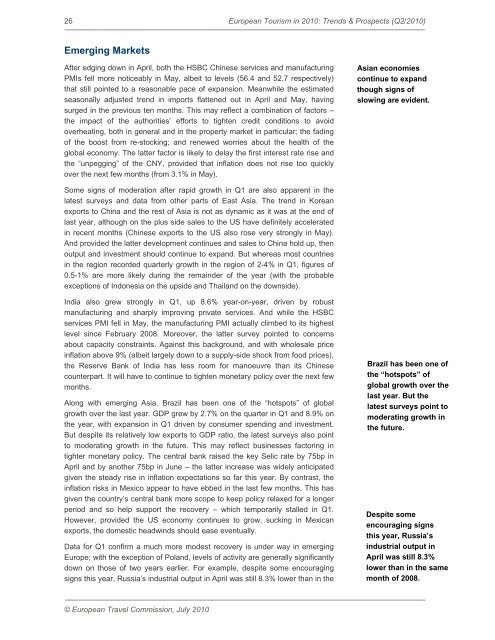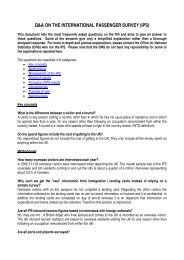EUROPEAN TOURISM 2010 â Trends & Prospects - VisitBritain
EUROPEAN TOURISM 2010 â Trends & Prospects - VisitBritain
EUROPEAN TOURISM 2010 â Trends & Prospects - VisitBritain
Create successful ePaper yourself
Turn your PDF publications into a flip-book with our unique Google optimized e-Paper software.
26 European Tourism in <strong>2010</strong>: <strong>Trends</strong> & <strong>Prospects</strong> (Q2/<strong>2010</strong>)Emerging MarketsAfter edging down in April, both the HSBC Chinese services and manufacturingPMIs fell more noticeably in May, albeit to levels (56.4 and 52.7 respectively)that still pointed to a reasonable pace of expansion. Meanwhile the estimatedseasonally adjusted trend in imports flattened out in April and May, havingsurged in the previous ten months. This may reflect a combination of factors –the impact of the authorities’ efforts to tighten credit conditions to avoidoverheating, both in general and in the property market in particular; the fadingof the boost from re-stocking; and renewed worries about the health of theglobal economy. The latter factor is likely to delay the first interest rate rise andthe “unpegging” of the CNY, provided that inflation does not rise too quicklyover the next few months (from 3.1% in May).Asian economiescontinue to expandthough signs ofslowing are evident.Some signs of moderation after rapid growth in Q1 are also apparent in thelatest surveys and data from other parts of East Asia. The trend in Koreanexports to China and the rest of Asia is not as dynamic as it was at the end oflast year, although on the plus side sales to the US have definitely acceleratedin recent months (Chinese exports to the US also rose very strongly in May).And provided the latter development continues and sales to China hold up, thenoutput and investment should continue to expand. But whereas most countriesin the region recorded quarterly growth in the region of 2-4% in Q1, figures of0.5-1% are more likely during the remainder of the year (with the probableexceptions of Indonesia on the upside and Thailand on the downside).India also grew strongly in Q1, up 8.6% year-on-year, driven by robustmanufacturing and sharply improving private services. And while the HSBCservices PMI fell in May, the manufacturing PMI actually climbed to its highestlevel since February 2008. Moreover, the latter survey pointed to concernsabout capacity constraints. Against this background, and with wholesale priceinflation above 9% (albeit largely down to a supply-side shock from food prices),the Reserve Bank of India has less room for manoeuvre than its Chinesecounterpart. It will have to continue to tighten monetary policy over the next fewmonths.Along with emerging Asia, Brazil has been one of the “hotspots” of globalgrowth over the last year. GDP grew by 2.7% on the quarter in Q1 and 8.9% onthe year, with expansion in Q1 driven by consumer spending and investment.But despite its relatively low exports to GDP ratio, the latest surveys also pointto moderating growth in the future. This may reflect businesses factoring intighter monetary policy. The central bank raised the key Selic rate by 75bp inApril and by another 75bp in June – the latter increase was widely anticipatedgiven the steady rise in inflation expectations so far this year. By contrast, theinflation risks in Mexico appear to have ebbed in the last few months. This hasgiven the country’s central bank more scope to keep policy relaxed for a longerperiod and so help support the recovery – which temporarily stalled in Q1.However, provided the US economy continues to grow, sucking in Mexicanexports, the domestic headwinds should ease eventually.Data for Q1 confirm a much more modest recovery is under way in emergingEurope; with the exception of Poland, levels of activity are generally significantlydown on those of two years earlier. For example, despite some encouragingsigns this year, Russia’s industrial output in April was still 8.3% lower than in theBrazil has been one ofthe “hotspots” ofglobal growth over thelast year. But thelatest surveys point tomoderating growth inthe future.Despite someencouraging signsthis year, Russia’sindustrial output inApril was still 8.3%lower than in the samemonth of 2008.© European Travel Commission, July <strong>2010</strong>






